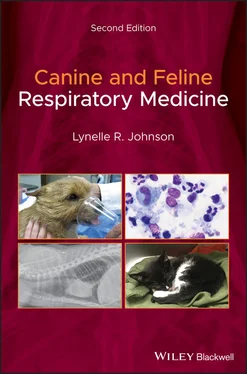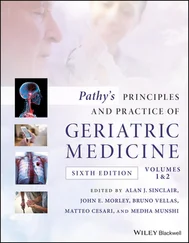1 ...6 7 8 10 11 12 ...19 Dogs with pulmonary hypertension as a consequence of primary lung disease can also display a prominent heart murmur. Heart murmurs in cats are neither sensitive nor specific for heart disease, because a substantial proportion of cats with hypertrophic cardiomyopathy lack a heart murmur and the physiologic murmur of right ventricular outflow tract obstruction is very common in cats.
Detection of a gallop sound is highly suggestive of substantial cardiac disease, particularly hypertrophic cardiomyopathy in the cat and dilated cardiomyopathy in the dog. Arrhythmias, and especially tachyarrhythmias, with pulse deficits would be much more commonly encountered in an animal with heart disease than in an animal with a respiratory cause of signs.
Tachypnea or hyperpnea can be found in animals with disease of cardiac or respiratory origin. Pneumonia, pulmonary edema, and interstitial fibrosis result in restrictive lung disease due to stiffening of the pulmonary parenchyma that leads to rapid, shallow breathing. Pleural effusion of cardiac, respiratory, or systemic origin will also result in an elevated respiratory rate. In some dogs and cats with chronic bronchitis and in dogs with tracheobronchomalacia, increased expiratory effort, prolonged expiratory time, and abdominal effort on expiration can be seen. Wheezes might be ausculted on expiration in these animals or inspiratory and expiratory crackles heard in dogs. The crackles detected in animals with bronchial disease are generally harsher and moister than those heard in dogs or cats with pulmonary edema. In many animals with heart failure, lung sounds are relatively normal or only very fine, soft crackles can be ausculted. Crackles on inspiration can be prominent in dogs with pulmonary fibrosis, and these adventitious lung sounds can be ausculted over the entire thorax in animals with pulmonary fibrosis. Crackles in animals with pneumonia are sometimes localized to certain lung regions. In an animal with aspiration pneumonia, abnormal lung sounds may be localized to the cranioventral lung regions or the middle lung lobes.
If pleural effusion is present due to pulmonary, cardiac, or systemic causes, heart and lung sounds will be dampened ventrally, while lung sounds are heard in the dorsal lung regions. Pleural effusion due to right heart disease is generally associated with distention of the jugular veins due to increased venous pressure. A hepatojugular reflux, enlarged liver, or ascites may also be detected. In cats, pleural and pericardial effusion can occur due to left‐sided heart disease. Pleural effusion associated with infectious etiologies (pyothorax in the dog and cat or feline infectious peritonitis in the cat) is more likely to result in fever than non‐infectious causes.
Additional Considerations
A complete physical exam is warranted in all patients presenting with signs of respiratory disease, including cough, tachypnea, or difficulty breathing. Abdominal palpation might reveal the presence of ascites or an abdominal mass. A dilated fundic exam is important for investigating infectious diseases as the cause for respiratory signs, including feline infectious peritonitis, canine distemper virus, and fungal infections.
1 Clercx, C., Reichler, I., Peeters, D. et al. (2003). Rhinitis/bronchopneumonia syndrome in Irish wolfhounds. J. Vet. Intern. Med. 17 (6): 843–849.
2 Dickson, D., Little, C.J.L., Harris, J., and Rishniw, M. (2018). Rapid assessment with physical examination in dyspnoeic cats: the RAPID CAT study. J. Small Anim. Pract. 59 (2): 75–84.
3 Ferasin, L., Crews, L., Biller, D.S. et al. (2013). Risk factors for coughing in dogs with naturally acquired myxomatous mitral valve disease. J. Vet. Intern. Med. 27: 286–292.
4 Hawkins, E.C., Clay, L.D., Bradley, J.M., and Davidian, M. (2010). Demographic and historical findings, including exposure to environmental tobacco smoke, in dogs with chronic cough. J. Vet. Intern. Med. 24 (4): 825–831.
5 Lord, P., Hansson, K., Carnabuci, C. et al. (2011). Radiographic heart size and its rate of increase as tests for onset of congestive heart failure in cavalier King Charles spaniels with mitral valve regurgitation. J. Vet. Intern. Med. 25 (6): 1312–1319.
6 Lord, P., Hansson, K., Kvart, C., and Häggström, J. (2010). Rate of change of heart size before congestive heart failure in dogs with mitral regurgitation. J. Small Anim. Pract. 51: 210–218.
7 Merveille, A.C., Battaille, G., Billen, F. et al. (2014). Clinical findings and prevalence of the mutation associated with primary ciliary dyskinesia in old English sheepdogs. J. Vet. Intern. Med. 28 (3): 771–778.
8 Pollard, R.E., Johnson, L.R., and Marks, S.L. (2018). The prevalence of dynamic pharyngeal collapse is high in brachycephalic dogs undergoing videofluoroscopy. Vet. Radiol. Ultrasound 59 (5): 529–534.
9 Watson, P.J., Herrtage, M.E., Peacock, M.A., and Sargan, D.R. (1999). Primary ciliary dyskinesia in Newfoundland dogs. Vet. Rec. 144 (26): 718–725.
2 Respiratory Diagnostics
General
Laboratory Testing
Basic blood work – complete blood count (CBC) and biochemical panel – in combination with a urinalysis is often performed during the work‐up of a respiratory patient and can help support the presence of an underlying respiratory tract disease. With local infectious or inflammatory disease processes such as rhinitis and tracheobronchitis, hematologic changes are typically absent. In contrast, with parenchymal diseases such as bacterial or aspiration pneumonia or pyothorax, a neutrophilic leukocytosis is often found and a left shift on the leukogram supports the diagnosis of an infectious process. Neutrophilia or eosinophilia is reported in eosinophilic pneumonia/bronchopneumopathy and feline bronchial disease. Fungal pneumonia is anticipated to result in neutrophilia and monocytosis, reflecting the chronic nature of the disease. Chronic hypoxemia can result in polycythemia, although this is more common with right to left cardiac shunts. The presence of nucleated red blood cells can be an indicator of hypoxemia that has triggered bone marrow toxicity.
Biochemical abnormalities in respiratory diseases are usually non‐specific. Hyperglobulinemia can be found in feline bronchial disease, fungal pneumonia, chronic foreign body or aspiration pneumonia, or bronchiectasis due to chronic antigenic stimulation, and concurrent hypoalbuminemia is occasionally present as a negative acute phase reactant.
Molecular diagnostics are increasingly used to document the presence of an infectious organism, such as feline herpesvirus‐1, Bordetella , or Mycoplasma , in either upper or lower respiratory tract disease; however, there are important limitations to the interpretation of these results (see the sections on specific diseases). Also, it is critical to realize that a positive molecular assay indicates only the presence of nucleic acids of the organism, and does not confirm that the organism is responsible for the clinical disease identified.
Various biomarkers have been evaluated as a method for differentiating cardiac from respiratory disease in animals presenting for cough or respiratory difficulty. The most common biomarker evaluated is plasma N‐terminal pro‐brain natriuretic peptide (NT‐BNP), which is produced in response to ventricular strain or stretch. A commercially available enzyme‐linked immunosorbent assay (ELISA) test is available for dogs and cats, and a point‐of‐care in‐house test has been developed for cats. This biomarker is reliably elevated in dogs with congestive heart failure in comparison to dogs with respiratory disease; however, there is some overlap between groups and often the non‐cardiac causes of respiratory distress are poorly defined. It is unclear whether this test is of added benefit in comparison to history, physical examination, and ultrasound in dogs that have both cardiac and respiratory disease. A point‐of‐care test is available for assessing values for feline NT‐BNP, and this can be applied to serum and pleural effusion fluid. Positive BNP tests in combination with appropriate cardiac and lung ultrasound examination could reliably establish congestive heart failure as the cause of respiratory distress, although the plasma BNP test was elevated in over 25% of cats with respiratory distress that was not due to cardiac disease (Ward et al. 2018). Renal disease can also increase BNP levels, therefore caution is warranted in relying on a single test for a diagnosis.
Читать дальше












